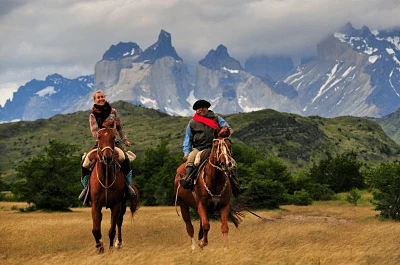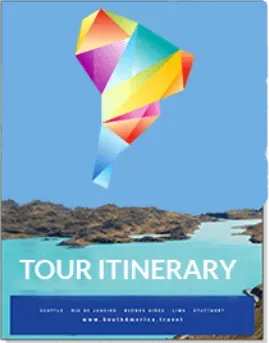Jul 1, 2015
|Last updated on December 28th, 2020 at 11:35 am
An Insider’s Guide to Torres del Paine National Park.
 Torres del Paine National Park in Patagonia is by far one of the most spectacular destinations in South America. The park has over 1 million acres of incredible scenery and wildlife, complete with 60+ miles of hiking trails.
Torres del Paine National Park in Patagonia is by far one of the most spectacular destinations in South America. The park has over 1 million acres of incredible scenery and wildlife, complete with 60+ miles of hiking trails.
Spend a week in Torres del Paine admiring the glaciers, granite valleys, glacial lakes, ice-capped peaks, and see guanacos, pumas, and Andean grey foxes. With our new Explora Patagonia Tour, traveling to Torres del Paine National Park has never been easier.
Keep reading for an insider’s guide to Torres del Paine National Park.
How do I get to Torres del Paine National Park?
- If Visiting Chile, Fly to Punta Arenas: From Santiago de Chile, International Airport takes a 4-hour flight to Punta Arenas Airport. Then take a 4 and a half hour bus ride from Punta Arenas to Torres del Paine.
- If Visiting Argentina, Fly to El Calafate: From the Buenos Aires Airport, take a 4-5 hour connecting flight to El Calafate. From El Calafate, take a 4-hour bus to Cerro Castillo and cross the border into Torres del Paine National Park.
Where to Stay in Torres del Paine?
I recommend staying at the Explora Patagonia Lodge. This is the most luxurious lodge in all of Torres del Paine. The Explora Patagonia lodge goes above and beyond to provide their guests with the finest treatment in this remote destination.
If you want to enjoy the outdoors, but still like to pamper yourself with fine wines and comfortable beds, the Explora lodge is for you. The lodge is located on the shore of Lake Pehoé surrounded by spectacular views of granite towers and ridges. Explora Amenities & Services
- Spa, Sauna & Pool
- 4 open-air jacuzzi’s with views of Lake Pehoé and the Paine Massif
- Fully stocked bar with the finest Chilean wines and liquors
- English speaking Guides
- Over 50 explorations throughout the park including hiking and horseback riding
- All Transfers are covered by Explora
- All-Inclusive
When is the best time to visit Torres del Paine?
The high season is December – February, so I recommend planning your trip for October – November to avoid crowds. However, the Explora Patagonia lodge is open year-round and Torres del Paine is beautiful throughout the entire year.
There is less rain during the spring and summer months and over 16 hours of natural light. Keep in mind that if you are traveling during the winter months, you may experience some closures due to severe weather.
Activities in Torres del Paine?
Kayaking at Glacier Grey
 You have several options for visiting Glacier Grey, but I recommend kayaking around the glacier. You can either kayak on Grey Lake and kayak through what they call the Iceberg Graveyard.
You have several options for visiting Glacier Grey, but I recommend kayaking around the glacier. You can either kayak on Grey Lake and kayak through what they call the Iceberg Graveyard.
Or you can take a boat to the face of the glacier and kayak all the way across the face of Glacier Grey. The second option is a bit more challenging and is reserved for those that are in good physical shape.
Hiking
Torres del Paine has over 60 miles of trails throughout the park all ranging from easy walks to more challenging treks. The “W Trek” is typically a 4-day circuit with mountain huts and camping along the way.
If you prefer staying at the Explora lodge, you can still do the 3 main “W Trek” hikes as day hikes to Grey Glacier, the Towers, and the French Valley. Read more about our Trekking Tour in Torres del Paine here.
Horseback Riding
 Spend a day horseback riding through Torres del Paine National Park and visit some of the best lookouts in the park. Learn about the flora and fauna on this full-day or half-day excursion.
Spend a day horseback riding through Torres del Paine National Park and visit some of the best lookouts in the park. Learn about the flora and fauna on this full-day or half-day excursion.
Don’t be surprised if you pass through small rivers on your trip. Explora Patagonia is the only lodge in the area with its own horses, bred, and trained by Explora specialists with the traveler’s expeditions in mind.
Photo Safari to Observe Flora, Fauna & Birds
This is the ideal tour for those who have a passion for nature and photography! Explora guides will take you through the Paine Horns, the Paine Towers, the Almirante Peak, and the Paine River Waterfall.
On this Photo Safari, you might encounter guanacos, skunks, foxes, a pump (if you’re lucky), and birds like rheas, skunks, ducks, geese, condos. Springtime is the best season for spotting birds.
Glacier Trekking on Glacier Grey
If you are looking for more of an adventure, go on a half-day or full-day guided Glacier Trekking Tour. Your guides will use their ice axes to carve out walking trails.
Admire the spectacular crevasses with sparkling blue water running below the glacier. As your day on the glacier comes to an end, don’t be surprised if your guides bring out a bottle of liquor and chill it with some 100-year-old ice from the glacier. **Crampons are provided** Hike to the Towers
 If you want a challenging yet rewarding hike, I recommend spending a day doing this 17 km hike to one of the most spectacular viewing points in Torres del Paine. Start your journey through the Ascencio River Valley towards the Chileno Shelter.
If you want a challenging yet rewarding hike, I recommend spending a day doing this 17 km hike to one of the most spectacular viewing points in Torres del Paine. Start your journey through the Ascencio River Valley towards the Chileno Shelter.
From there, walk along the ancient beach forest surrounded by a beautiful ravine. The final and most difficult push on this hike is a scramble through the moraine. At the top, you will be greeted by the magnificent Towers.
If it isn’t too windy at the top, relax at the glacial lake and enjoy a delicious lunch. Soak-in this moment and feel the soothing Patagonian atmosphere. Make sure to bring a rain jacket with you because you never know when the weather can drastically change.
What is the weather like?
The weather in Torres del Paine National Park can drastically change within minutes. It is typical to experience rain, sunshine, hail storms, and strong wind storms on the same day. The west side of the Andes brings in a cold coastal climate and the east side brings in a cold grassland climate.
I recommend bringing a small backpack on all outings with a waterproof jacket, waterproof pants, sunscreen, and flashlight to be safe.
How can I start planning my Torres del Paine adventure?
Mentioned in this article








